人教精通版小学六年级上册英语教案(全册-共80页)
【人教精通版】小学英语六年级上册全册教案(word版177页)
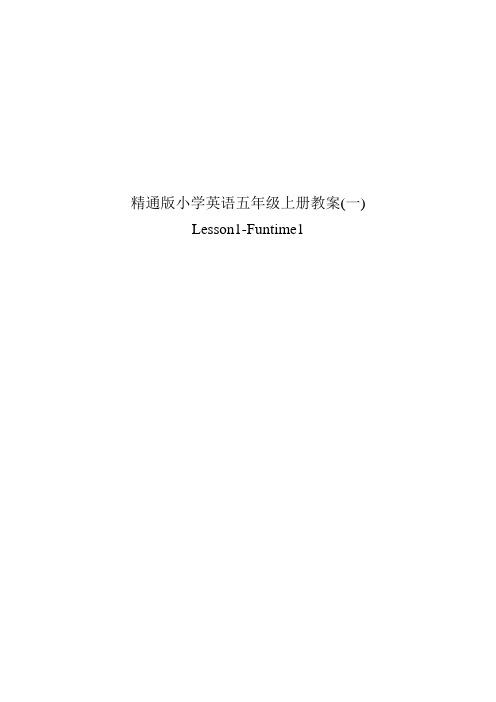
精通版小学英语五年级上册教案(一)Lesson1-Funtime1一、教材特点1、适应儿童特点,采用行动学习法。
2、引入项目制作,实现任务型教学。
3、提倡合作学习,培养合作精神。
4、强调语言真实自然,培养学生表达真实感受的能力。
5、重双向交流,增强文化意识。
6、注重形成性评价,促进学生发展。
7、实现整体设计,确保中小学衔接。
目标要求:•1、能听懂、会说20组会话,并能进行简单的交流。
•2、能听、说、读、写84个单词,并能再听说认读43个单词。
•3、能听、说、认读,并能简单运用16组语句。
•4、能听、做11 个游戏。
•5、能够完成4个调查活动。
•6、能听、做、2个表演活动。
•7、能学会2个小制作。
•8、能唱2首英文歌曲。
•9、能听、说、唱18首歌谣。
•10、能完成24个检测评价活动。
•11、能听懂、认读,并能简单表演6个小故事。
•12、能初步了解2项中西方文化知识。
Unit 1单元目标分析言语技能目标:1、能向他人介绍自己朋友的基本情况;能够向新朋友介绍自己的基本情况。
包括姓名、年龄、所在班级、住址、电话号码以及所在国家、城市或地区。
2、能够在适当的情景中,简单描述自己朋友的外貌特征和个人特点。
语言知识目标:单词:clever quiet prertty Britain Australia New Zealand street road I you am is my your her his what name friend in grade eye nose mouth 句子:I come from Britain. Where do you live? I live on Purple Street.I live at Purple Street. She is cute. He is clever. I`m Bob. I`m eleven.What`s your name? My name is ZhouPei. What class are you in?I`m in Class One,Grade Five. What`s her name? Her name is ZhouPei. What`s his name? His name is Peter.能够正确说唱3个chants.情感态度目标:1、进一步提高对英语学习的热情,培养更加稳定的学习兴趣。
人教精通版小学六年级英语上册教案
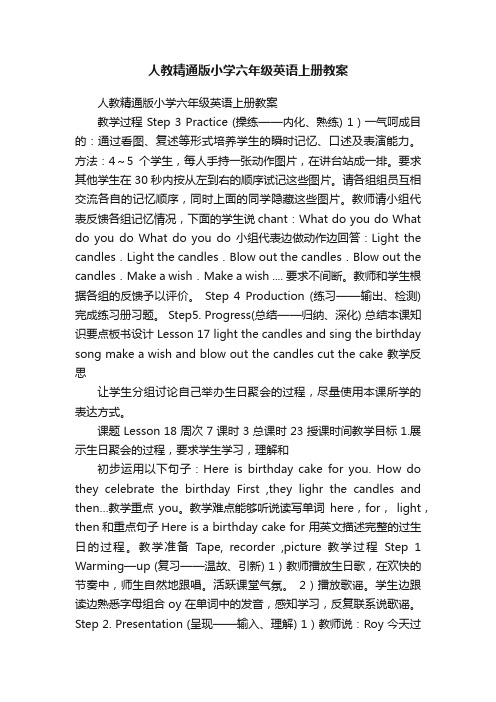
人教精通版小学六年级英语上册教案人教精通版小学六年级英语上册教案教学过程 Step 3 Practice (操练——内化、熟练) 1)一气呵成目的:通过看图、复述等形式培养学生的瞬时记忆、口述及表演能力。
方法:4~5个学生,每人手持一张动作图片,在讲台站成一排。
要求其他学生在30秒内按从左到右的顺序试记这些图片。
请各组组员互相交流各自的记忆顺序,同时上面的同学隐藏这些图片。
教师请小组代表反馈各组记忆情况,下面的学生说chant:What do you do What do you do What do you do 小组代表边做动作边回答:Light the candles.Light the candles.Blow out the candles.Blow out the candles.Make a wish.Make a wish .... 要求不间断。
教师和学生根据各组的反馈予以评价。
Step 4 Production (练习——输出、检测) 完成练习册习题。
Step5. Progress(总结——归纳、深化) 总结本课知识要点板书设计 Lesson 17 light the candles and sing the birthday song make a wish and blow out the candles cut the cake 教学反思让学生分组讨论自己举办生日聚会的过程,尽量使用本课所学的表达方式。
课题 Lesson 18 周次 7 课时 3 总课时 23 授课时间教学目标 1.展示生日聚会的过程,要求学生学习,理解和初步运用以下句子:Here is birthday cake for you. How do they celebrate the birthday First ,they lighr the candles and then…教学重点you。
教学难点能够听说读写单词here,for,light,then和重点句子Here is a birthday cake for 用英文描述完整的过生日的过程。
人教精通版小学英语六年级上全册教案

人教精通版小学英语六年级上全册教案全册教材分析六年级上册每单元6课,每2课3页的设计:次序教学内容活动形式会话 Just speak.词汇与句子 Just practice.Just write.任务 Let's find.表演 Let's act。
游戏 Let's play.小制作 Let's make.语音 Let's read and chant.复习趣味故事 Fun story.六年级上册每个单元的设计:次序教学内容活动形式检测 Let's check.游戏 Let's play.Let’s find out.歌曲 Let's sing.歌谣 Let's chant.小制作 Let's make.同1-2页同1-2页项目制作 ProjectCulture单元教学计划第(一)单元总课时:六单元教材分析1.听、说、读、写:carefully ask make eat should go early home go home look out must wait good 句型:2.听、说、认读:Don’t be late for class/school.You shouldn’t make a mess in your room.You mustn’t cross the road now!能够正确说唱本单元的3个chants,熟悉辅3.音字母组合ch的正确发音、辅音字母组合ur的正确发音和元音字母组合oo的正确发音,要求发音准确清晰。
单元教学目标1.听、说、读、写:Listen to the teacher carefully.You should go to bed early.Look out! You must wait.2.学会祈使句的用法和写法教学重点难点1.能熟练运用should must 等情态动词造句 2.能够正确地听,说,认读祈使句课时安排课次教学内容1 Lesson One2 Lesson Two3 Lesson Three4 Lesson Four5 Lesson Five6 Lesson Six课时授课教案课题Lesson One 第 1 单元第 1 课第 1 节教学目标1.To learn to say the text of this lesson.2. 学会用英语说班规教学重点难点1.Listen to the teacher carefully.2.Hand in your homework on time. 3.根据本课所学的内容造句课前准备录音机,磁带,教学挂图Step 1.Revision1. To review to sing a song: Nice to see you again. Step2. Knowledge and drills1. To talk about the picture by using the sentences:2. Let’s meet our old friends.3. Who is this boy? Yes, this is Gao Wei and theseare his classmates. What are they doing? ...4. To learn to say the sentences:What do you call it in English? We call it…5. To learn to say the dialogue.6. Let the students listen to the tape recordingStep 1.Revision1. To review to sing a song: Nice to see you again. Step2. Knowledge and drills1. To talk about the picture by using the sentences:2. Let’s meet our old friends.3. Who is this boy? Yes, this is Gao Wei and theseare his classmates. What are they doing? ...4. To learn to say the sentences:What do you call it in English? We call it…板书设计 Lesson OneListen to the teacher carefully.Hand in your homework on time.作业设计:1.Listen, read and recite the text and words..2.Try to make up new text. 课后反思:课时授课教案课题Lesson Two 第 1 单元第 2 课第 1 节教学目标 1. Just practice2. Just write3. Let’s play4. Let’s read and chant教学重点难点祈使句的肯定句1.Listen to the teacher carefully. 祈使句的否定句2.Don’t be late for school.课前准备录音机,磁带,教学挂图.教学过程修改记录Step 1. Revision:1.Review to say some animals.2.To review the text of Lesson One.3.To make up sentences by using pattern:Listen to the teacher carefully.Don’t be late for school.Step 2. Knowledge and drills:1.To learn to say and write the sentences:Ask questions actively.Don’t make noise.Be quiet.Don’t eat in class.May I ask your question? (Yes, of course.)To practice the sentences.2.To learn to say and write the words:ask make eat carefullyLet the students listen to the tape and read afterthe tape recording. Try to say sentences and wordsfluently.3.Try to make up new sentences by using the pattern.板书设计Lesson TwoListen to the teacher carefully. 作业设计:Copy and recitethe words,drills.课后反思:。
最新人教精通版小学六年级上册英语教案(全册-共80页)
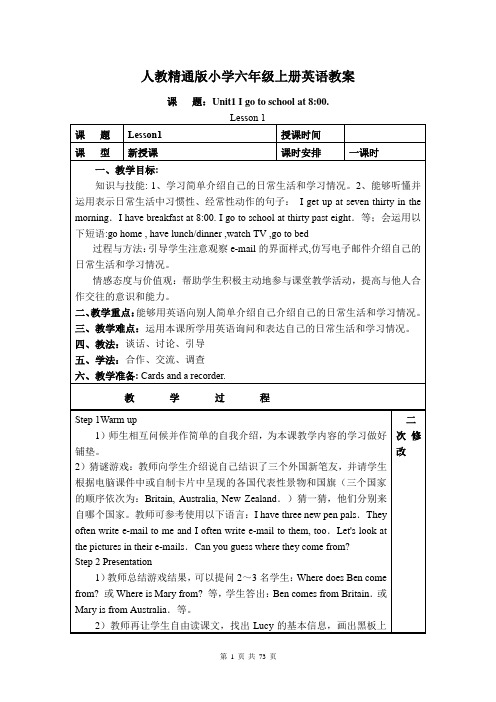
人教精通版小学六年级上册英语教案课题:Unit1 I go to school at 8:00.课题:Unit1 I go to school at 8:00.课题:Unit1 I go to school at 8:00.课题:Unit1 I go to school at 8:00.课题:Unit1 I go to school at 8:00.课题:Unit1 I go to school at 8:00.课题:Unit 2 What’s your hobby?课题:Unit 2 What’s your hobby?课题:Unit 2 What’s your hobby?课题:Unit 2 What’s your hobby?课题:Unit 2 What’s your hobby?Lesson 11课题:Unit 2 What’s your hobby?课题:Unit3 Would you like to come to my birthday party?一边展示十二个生肖图片及单词,一边做Let's do: Act like a..... (引入12生肖,指导学生了解其中几个12生肖的生词)2. Presentation (15′)1)指导学生制作生日邀请卡。
2)学习短语invite your friends to your party, celebrate your birthday with your friends, give a birthday card to your friend.3)运用邀请卡练习会话:Would you like to come to my birthday party? Sure. I’d love to. Here’s a card for you! Thank you! Goodbye!/ Bye-bye!/ Bye!4)Listen and repeat.T: Listen to the tape and then read after it.5)Just write.T wrtie Four Skills’ words and sentences on blackboard, ask Ss to follow.6)Let’s read and chant:播放Let's read and chant部分的录音两遍。
人教精通版六年级英语上册教案
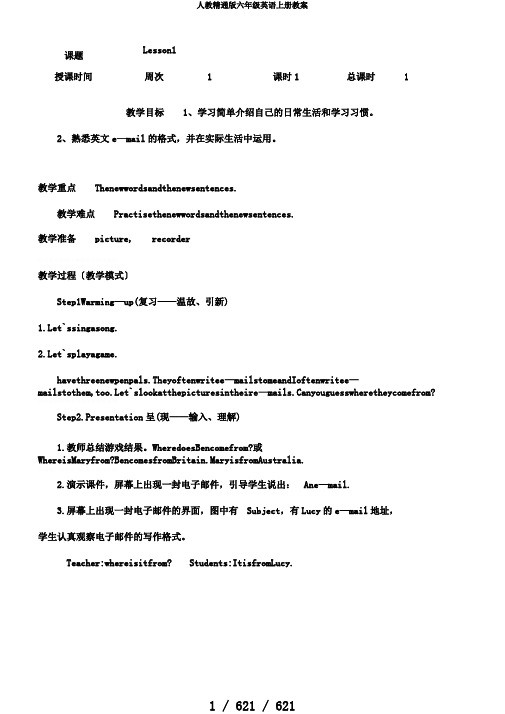
Lesson1课题授课时间周次1课时1总课时1教学目标1、学习简单介绍自己的日常生活和学习习惯。
2、熟悉英文e—mail的格式,并在实际生活中运用。
教学重点Thenewwordsandthenewsentences.教学难点Practisethenewwordsandthenewsentences.教学准备picture, recorder教学过程〔教学模式〕Step1Warming—up(复习——温故、引新)1.Let`ssingasong.2.Let`splayagame.havethreenewpenpals.Theyoftenwritee—mailstomeandIoftenwritee—mailstothem,too.Let`slookatthepicturesintheire—mails.Canyouguesswheretheycomefrom?Step2.Presentation呈(现——输入、理解)1.教师总结游戏结果。
WheredoesBencomefrom?或WhereisMaryfrom?BencomesfromBritain.MaryisfromAustralia.2.演示课件,屏幕上出现一封电子邮件,引导学生说出:Ane—mail.3.屏幕上出现一封电子邮件的界面,图中有Subject,有Lucy的e—mail地址,学生认真观察电子邮件的写作格式。
Teacher:whereisitfrom? Students:ItisfromLucy.Teacher:Yes,itisfrommynewfriendLucy.Buthowdoyouknowthat?Oh,youcanseethe—emailaddress.Doyouhavean—emailaddress?tothetapeaccordingtothequestions.Whatisthee—mailabout? Wheredoesshehavelunch?WheredoesLucycomefrom?WhendoesLucygetup?Whatdoesshedoafterdinner?Whendoclassesbegin?Whendoesschoolend?Doesshegotobedlate?5.Tolearnthee—mail.Step3Practice操(练——内化、熟练)Listentothetapeandreadthe—email.Step4Production(练习——输出、检测)Fillintheblanks.Hi,LiYan.Mynameis______.Icomefrom________.I`m_______.Igetupat_____everymorning.Ihaveclassesfrom______to_______.Ihave_______atschoolatgethomeatabout_________.ThenIdomy__________.板书设计Lesson1getup gotoschoolhavedinner gethomewatchTV gotobed教学反思〔总结——归纳、深化〕〔目标达结合生活情景引入本课目标语言,让学生整体感知、理解、学习,运成〕用目标语言进行交流。
全新人教精通版六年级英语上册教案(全册 共131页)
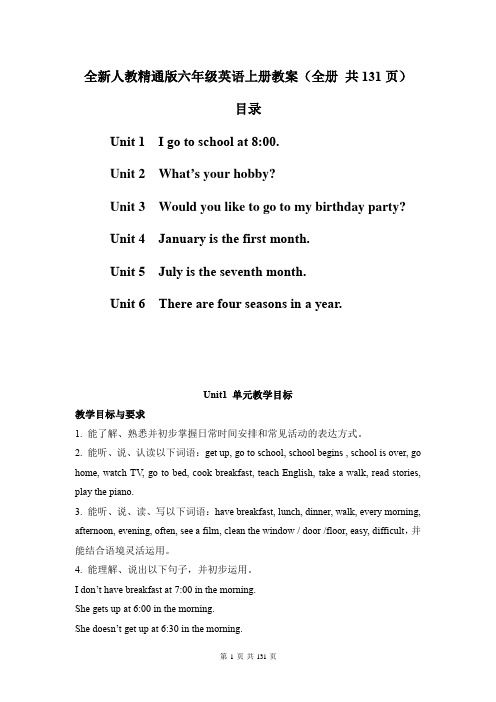
全新人教精通版六年级英语上册教案(全册共131页)目录Unit 1 I go to school at 8:00.Unit 2 What’s your hobby?Unit 3 Would you like to go to my birthday party?Unit 4 January is the first month.Unit 5July is the seventh month.Unit 6There are four seasons in a year.Unit1 单元教学目标教学目标与要求1. 能了解、熟悉并初步掌握日常时间安排和常见活动的表达方式。
2. 能听、说、认读以下词语:get up, go to school, school begins , school is over, go home, watch TV, go to bed, cook breakfast, teach English, take a walk, read stories, play the piano.3. 能听、说、读、写以下词语:have breakfast, lunch, dinner, walk, every morning, afternoon, evening, often, see a film, clean the window / door /floor, easy, difficult,并能结合语境灵活运用。
4. 能理解、说出以下句子,并初步运用。
I don’t have breakfast at 7:00 i n the morning.She gets up at 6:00 in the morning.She doesn’t get up at 6:30 in the morning.What does Kate do on Saturdays?She usually plays the piano.5. 能听、说、读、写以下句子:I have breakfast at 7:30.I have lunch at 12:00.I have dinner at 6:00.What do you do on Saturdays?I often go and see a film.6. 能说唱本单元的3首歌谣,熟悉字母组合ea和ee在单词中的发音规律,培养单词拼读能力和利用读音规律识记单词的能力。
人教版六年级上册英语全册教案
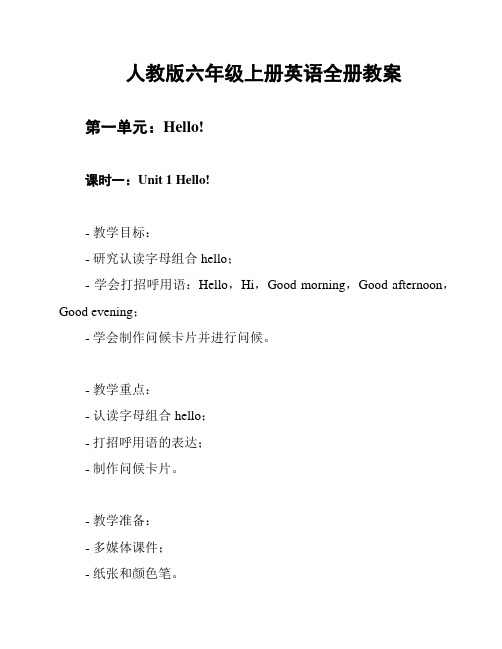
人教版六年级上册英语全册教案第一单元:Hello!课时一:Unit 1 Hello!- 教学目标:- 研究认读字母组合hello;- 学会打招呼用语:Hello,Hi,Good morning,Good afternoon,Good evening;- 学会制作问候卡片并进行问候。
- 教学重点:- 认读字母组合hello;- 打招呼用语的表达;- 制作问候卡片。
- 教学准备:- 多媒体课件;- 纸张和颜色笔。
- 教学过程:1. 通过多媒体课件展示字母组合hello,并引导学生跟读。
2. 分组进行角色扮演,学生互相使用打招呼用语进行问候,并创造各种情境让学生进行练。
3. 引导学生制作问候卡片,并鼓励他们用所学到的打招呼用语互相送卡片并问候。
4. 结束课堂,鼓励学生在日常生活中积极运用所学内容。
课时二:Unit 2 My Family- 教学目标:- 研究称呼家庭成员的词汇:father,mother,brother,sister;- 学会描述家庭成员的外貌特征。
- 教学重点:- 家庭成员词汇的研究;- 外貌特征的描述。
- 教学准备:- 多媒体课件;- 图片和描述卡片。
- 教学过程:1. 通过多媒体课件展示家庭成员的图片,并教授相应的称呼词汇。
2. 引导学生进行对话练,描述自己的家庭成员的外貌特征。
3. 使用图片和描述卡片,让学生进行配对练,熟练掌握与外貌特征相关的词汇。
4. 结束课堂,鼓励学生回家和家人进行交流并用英语描述家庭成员。
...课时六:Unit 6 At the Zoo- 教学目标:- 研究动物名称的词汇:elephant,panda,kangaroo,tiger;- 学会描述动物的特征和生活性。
- 教学重点:- 动物名称的研究;- 描述动物特征和生活性。
- 教学准备:- 多媒体课件;- 图片和描述卡片。
- 教学过程:1. 通过多媒体课件展示各种动物的图片,并教授相应的名称词汇。
2. 分组进行角色扮演,引导学生用所学到的词汇描述动物的特征和生活性。
最新人教精通版小学英语六年级上册优质教案(全册)
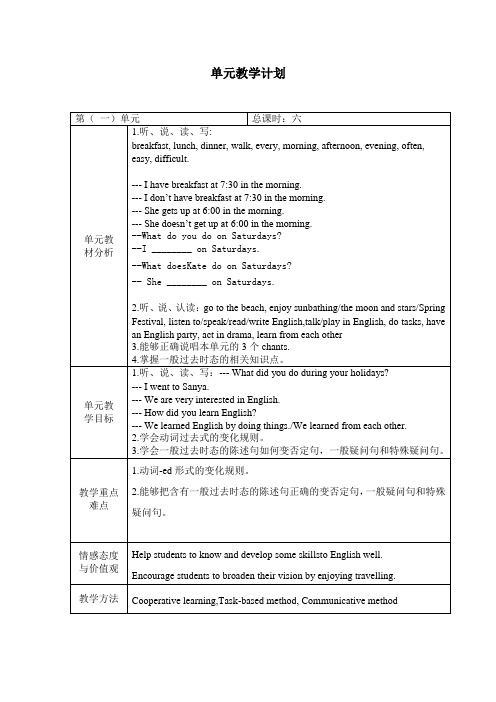
--- We learned English by doing things./We learned from each other.
2.学会动词过去式的变化规则。
3.学会一般过去时态的陈述句如何变否定句,一般疑问句和特殊疑问句。
教学重点难点
课型:Reading
教学准备:Books and pictures, multi-media, blackboard-writing
教学过程与方法
教学环节
教学活动
设计意图
课前德育渗透
Step 1
Step 2
Step 3
Step 4
Step 5
时间观念的涵义是要科学地安排时间,计划用时间,讲究效率,还需要有自控能力。因此,一般家长认为是对成人的要求,而忽视了对孩子的培养。若是父母能在早期养成孩子良好的时间观念,就等于给孩子以知识、力量、聪明和美好的开端。因为善于掌握自己时间的人将会获得高效率工作,也是最能出成绩的人。作为一名学生,要有时间观念,做事不拖拉。
教学重点:Listen to the teacher carefully and recite words correctly.
教学难点:To master the reading skills (fast reading and careful reading).
教学方法:Cooperative learning, Task-based method
单元教学计划
第(一)单元
总课时:六
单元教
材分析
1.听、说、读、写:
breakfast, lunch, dinner, walk, every, morning, afternoon, evening, often,
人教精通版六年级上册英语教案全英
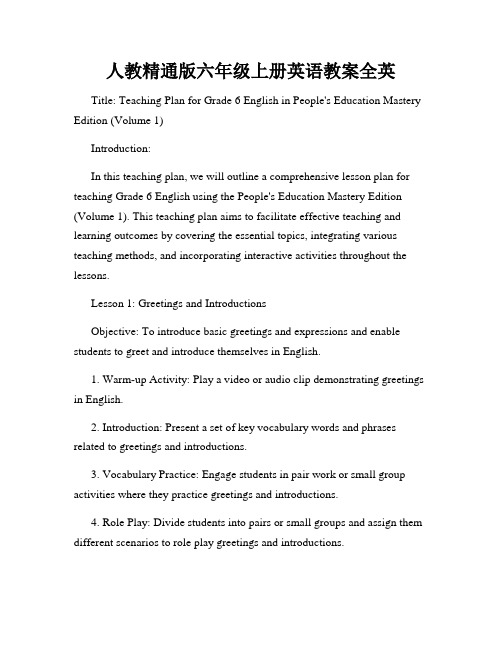
人教精通版六年级上册英语教案全英Title: Teaching Plan for Grade 6 English in People's Education Mastery Edition (Volume 1)Introduction:In this teaching plan, we will outline a comprehensive lesson plan for teaching Grade 6 English using the People's Education Mastery Edition (Volume 1). This teaching plan aims to facilitate effective teaching and learning outcomes by covering the essential topics, integrating various teaching methods, and incorporating interactive activities throughout the lessons.Lesson 1: Greetings and IntroductionsObjective: To introduce basic greetings and expressions and enable students to greet and introduce themselves in English.1. Warm-up Activity: Play a video or audio clip demonstrating greetings in English.2. Introduction: Present a set of key vocabulary words and phrases related to greetings and introductions.3. Vocabulary Practice: Engage students in pair work or small group activities where they practice greetings and introductions.4. Role Play: Divide students into pairs or small groups and assign them different scenarios to role play greetings and introductions.5. Consolidation: Wrap up the lesson with a class discussion and summarize the key points learned.Lesson 2: Daily RoutinesObjective: To teach students how to express daily routines and describe activities in English.1. Review: Begin the lesson with a quick review of greetings and introductions.2. Vocabulary Building: Present a list of verbs and adverbs related to daily routines.3. Listening Comprehension: Play a recording of different daily routines and have students match the activities with the corresponding time.4. Speaking Practice: Students work in pairs or small groups to create dialogues discussing their own daily routines.5. Extension Activity: Assign a short writing task where students describe their daily routines.Lesson 3: Family Members and RelationshipsObjective: To introduce vocabulary related to family members and relationships and enable students to talk about their family in English.1. Vocabulary Introduction: Present a list of family members and relationships vocabulary.2. Listening Activity: Play an audio clip where students listen and match family members with their descriptions.3. Interactive Discussion: Encourage students to discuss their own families in small groups or pairs using the target vocabulary.4. Speaking Practice: Students interview their classmates about their families and share the information with the rest of the class.5. Writing Activity: Assign a short writing task where students describe their family members and their relationships.Lesson 4: School Subjects and ActivitiesObjective: To teach students how to talk about school subjects and activities in English.1. Vocabulary Presentation: Introduce school subjects and related vocabulary.2. Listening Comprehension: Play a recording where students listen to various school activities and match them to the corresponding subjects.3. Interactive Activity: Divide students into small groups and ask them to create a timetable for a typical school day, using the target vocabulary.4. Speaking Practice: Students present their timetables to the class, explaining the subjects and activities included.5. Extension Activity: Assign a short writing task where students describe their favorite school subjects and activities.Conclusion:This teaching plan provides a structured approach to teaching Grade 6 English using the People's Education Mastery Edition (Volume 1). Byincorporating interactive activities, students are encouraged to actively participate in the learning process. These lessons cover essential topics such as greetings, daily routines, family members, and school subjects, enabling students to build a strong foundation in English language skills.。
新人教版六年级英语上册全英文教案(全册全英文)

新⼈教版六年级英语上册全英⽂教案(全册全英⽂)新⼈教版六年级英语上册全英⽂教案(全册)Unit 1 How do you go there?Period OneTeaching contents: Part A let’s learn & let’s playTeaching aims:1.To enable the students to master the four skills phrases: on foot,by bike,by bus,by train, by plane,by ship,by subway2.To enable the students to ask about the ways of traffic with the following sentence patterns: How do you go to school? Or How do you go to Canada…?”And answer with“I go by…”Teaching focus:To master the four skills phrases: by train, by plane, by subway, by ship, by bike, on footTeaching difficulty:To differ “subway” from“train”Teaching methods:Communicative ApproachTeaching aids:1.Word cards2.Tape recorder and tape3.Multi-media playerTeaching procedure:1. (Warm-up)Greeting: Good morning , class !Glad to meet you again. How are you?What day is it? What ‘s the date?What’s the weather like today?2. PresentationShow a picture of busT: What’s this? S: It’s a bus.T: I go to school by bus. How do you go to school?(Show a picture of bike and help a student to answer with “I go to school by bike.”) (In the same ways)Teach “by subway” and “by train” “by ship” “by plane” “on foot”.Subway: It's an underground railway in a city.It travels very fast.We can seesubway in Hong Kong, Beijing, Shanghai, Gongzhou…Explain the differences between subway and trainPay attention to the pre. “ by”& “on”3.Play gamesAsk one S to the front and stick the word cards next to the phrases written on the Bb when T read the new phrases quickly and the other Ss put up their cards. The one who reflect fastest and correctly is the winner.4.Listen to the tape of Part A Let’s learn and follow it.Pay attention to the tone and pronunciation5.Practice: Let’s playT Offer many places (the USA. England Australia Hong Kong Shanghai Guangzhou the moon…) and traffic ways (by car/ taxi/ bus… on foot)Ss practice with above places and ways in pairs:A: How do you go to school?B: I go to school on foot.Encourage the Ss to make up as many sentences as they can.6.Spelling competitionDivide the class into tow groups. Show the pictures of traffic tools and ask Ss to spell the phrases. The first one who puts up hand gets the chance to spell. The group spell out more phrases are the winners.HomeworkCopy the new words and phrasesFinish Page1 of the ABBb design:Unit One How do you go there?How do you go to school/ Canada?I go to school on foot/ by subway/ bus/ train/ taxi…Teaching reflection:Unit1 How do you go there? Period TwoTeaching contents: Let’s try & let’s talkTeaching aims:1.To master the four skills sentence: “How do you go to school? Usually I go toschool on foot.Sometimes I go by bike.”2.To enable the Ss to ask and answer about traffic ways and explain the simple reasonwhy he or she chose this traffic way.I go to school on foot, because my home is near.3.To make the Ss understand the listening material in “Let’s try” 情感⽬的Teaching focus:⽂中的新句⼦To use and write the following key sentences:How do you go to school?Usually I go to school by bike. Sometimes I go on foot.Teaching difficult points:To write the key sentences: How do you go to school?Usually I go to school on foot.Sometimes I go by bike.To use Adverbs of frequency: usually, sometimesTeaching aids:Tape recorder Teaching cards a piece of paperTeaching procedure:1. (Warm-up)T: Good morning! How do you go to school today? What about you? Do you go by bus,too?”2. Have a dictationAsk the Ss to dictate the new words learnt in the last lesson.On foot、by bus、by train、by plane、by subway…3. Let'stryGuide the Ss to look at the pictures and askWho’s the boy? He’s Mike. How does Mike go to school?Play the tape and listen:John:How do you go to school,Mike?Mike:I usually go to school by bike.Sometimes I go 0n foot.John:Is your home near our school?Mike:Yes.it is.J0hn:That's fine!4. (Presentation)Let's talkT: How do I go to school,do you know? Ask me,please!Draw a bike, a bus, a taxi on the Bb and write the price by each picture. Bus 1 yuan taxi 10 yuanEncourage the Ss to ask “How do you go to school?T: Usually I go to school by bike, because it's good exercise.Sometimes I go by bus,because it's cheap.It costs l yuan. Sometimes I go by taxi,because it's fast,butit's too expensive.It costs 1o yuan.Explain that we use usually and sometimes to express frequency.T: “How does Sarah go to school? Listen.”Ask the S to imitate Sarah’s tone to answerSarah: Usually I to go school on foot. Sometimes I go bike.Ss read after the tape. Then practice in pairs to make up the new dialogueaccording to each picture.Ask several pairs to act out the dialogue.5. Group workRead the dialogue .Then practice in groups of four. They can expand their dialogue like the following:A:How do you go to school/ hometown?B:Usually I go by bus.A:Can you go by bike?B: Yes,I can,but it's too far.Sometimes I go by taxi,because it’s fast, but it's expensive. What about you? A:I go to school on foot,because my home is near.6. Play finding order gamesShow the following word cards and ask Ss to form correct sentences.How, do, go, to, school, youI, usually, on, go, school, to, footSometimes, by, bike, go, IHomework:Finish AB Page2Bb designUnit1 How do you go there How do you go to school?Usually I go to school on foot, because it’s near.Sometimes I go by bike, because it’s fast.Period Three Teaching contents: Let’s readTeaching aims:1.To improve reading skill2.To consolidate the traffic ways3.To improve understanding ability.Teaching focus:How do we go to the park?It’s easy.How to finish answering the questions in the bookTeaching difficult points:How to express the different ways to a placeTeaching aids:Tape recorder a piece of paper masks of Zhang Peng and SarahTeaching procedure:1.ReviewFree talk2.Dictation 复习上节课学过的句⼦和词语How do you go to school?Usually I go to school on foot.Sometimes I go by bike. What about you?3.Review different placesT: This is a very nice place. There are many students and teachers. There are many rooms, such as classroom, art room, music room… What’s it?It’s a beautiful place. Many people like to play in it. There are nice flowers, trees and grass. There are toys. What is it?It’s a park.4.PresentationT: Where is my home? Do you want to know?Describe with different traffic ways and use “first” “next” “then” .It’s a little far from here. First I go to Zenbu bus stop on foot. Then I can go by the No.74 bus to the East Bus Station... We live on the ninth floor,Room902.Explain “then”5.T ask individual :Where is your home?Is it near the park? Which floor?In pairs practice above questions6.Play the tape and students follow it.Ask: How can we go to Sarah’s home?How can they go to the park?Finish answering the questions, and then check the answers.7.PracticeRead the text. Boys to be Zhang Peng ,and girls to be Sarah. 男⼥分组朗读Work in pairs to read the dialogue.Ask several pairs to act out.8.Make up new dialoguesHomework:Do Page 5 in ABMake a survey and fill in the following formBb design:How do we go to the park?It’s easy.Which floor?The fifth floor, Room 5APeriod FourTeaching contents: Let’s learn and let’s playTeaching aims:1. To master the phrases: Stop at a red light. Wait at a yellow light. Go at a green light.2. To know some traffic rules about traffic lightsTeaching focus:To understand the traffic lights commands and do the action:Stop at a red light.Wait at a yellow light.Go at a green light.Teaching difficult points:To understand the meaning of the three traffic lights and do the correct action ofthe commandsTeaching aids:Tape recorderA flash card of traffic lightsWord cards。
【精品】人教精通版小学英语六年级上册全册教案(155页)

人教版精通版英语精品资料精通版小学英语五年级上册教案(一)Lesson1-Funtime1一、教材特点1、适应儿童特点,采用行动学习法。
2、引入项目制作,实现任务型教学。
3、提倡合作学习,培养合作精神。
4、强调语言真实自然,培养学生表达真实感受的能力。
5、重双向交流,增强文化意识。
6、注重形成性评价,促进学生发展。
7、实现整体设计,确保中小学衔接。
目标要求:•1、能听懂、会说20组会话,并能进行简单的交流。
•2、能听、说、读、写84个单词,并能再听说认读43个单词。
•3、能听、说、认读,并能简单运用16组语句。
•4、能听、做11 个游戏。
•5、能够完成4个调查活动。
•6、能听、做、2个表演活动。
•7、能学会2个小制作。
•8、能唱2首英文歌曲。
•9、能听、说、唱18首歌谣。
•10、能完成24个检测评价活动。
•11、能听懂、认读,并能简单表演6个小故事。
•12、能初步了解2项中西方文化知识。
Unit 1单元目标分析言语技能目标:1、能向他人介绍自己朋友的基本情况;能够向新朋友介绍自己的基本情况。
包括姓名、年龄、所在班级、住址、电话号码以及所在国家、城市或地区。
2、能够在适当的情景中,简单描述自己朋友的外貌特征和个人特点。
语言知识目标:单词:clever quiet prertty Britain Australia New Zealand street road I you am is my your her his what name friend in grade eye nose mouth 句子:I come from Britain. Where do you live? I live on Purple Street.I live at Purple Street. She is cute. He is clever. I`m Bob. I`m eleven.What`s your name? My name is ZhouPei. What class are you in?I`m in Class One,Grade Five. What`s her name? Her name is ZhouPei. What`s his name? His name is Peter.能够正确说唱3个chants.情感态度目标:1、进一步提高对英语学习的热情,培养更加稳定的学习兴趣。
人教精通版六年级上册英语教案

人教精通版六年级上册英语教案第一课时:Unit 1 Hello!教学目标:1. 学生能够听、说、认读并能书写26个英文字母。
2. 学生能够用英语进行个人的自我介绍。
3. 学生能够灵活运用问候语相互交流。
教学重点:1. 学生能够正确地听、说、认读26个英文字母。
2. 学生能够用英语进行自我介绍。
教法:任务型教学法,情景教学法教学准备:PPT课件,挂图,音频设备,黑板教学过程:Step 1: Greeting (5 minutes)- T: Good morning, students!- Ss: Good morning, teacher!- T: How are you today?- Ss: I'm fine, thank you. And you?- T: I'm fine too. Thank you.Step 2: Presentation (15 minutes)- T: Now, let's learn the English alphabet. First, I'll show you the uppercase letters. (Teacher shows the PPT with the uppercase letters.)- T: Repeat after me and pay attention to the pronunciation. Let's go!- Ss: (Repeat after the teacher)- T: Great! Now, let's learn the lowercase letters. (Teacher shows the PPT with the lowercase letters.)- T: Repeat after me, and remember the shape of each letter. Let's go!- Ss: (Repeat after the teacher)Step 3: Practice (20 minutes)- T: Now, let's practice the letters together. I'll show you a letter, and you tell me its name and the sound it represents.- T: (Teacher shows a flashcard with a letter)- S1: It's "A". The sound is /æ/.- T: Excellent! Now, let's continue.- T: (Teacher shows another flashcard with a letter)- S2: It's "B". The sound is /b/.- T: Well done! Keep it up!- T: (Teacher continues showing flashcards and students provide answers accordingly.)Step 4: Introduction (10 minutes)- T: OK, now I want each of you to say your name and an English letter that starts with the same sound as your name.- T: For example, my name is Miss Smith, and I'll say "My name starts with 'S', just like 'Smith'."- S1: (Student says their name and an English letter)- T: Well done! Let's continue.Step 5: Role Play (15 minutes)- T: Now, let's practice some basic greetings and introductions. I'll give you different scenarios, and I want you to act them out in pairs.- T: Scenario 1: You meet a new classmate. Introduce yourselves and say hello.- T: Scenario 2: You meet your teacher in the morning. Greet your teacher and ask how he/she is doing.- T: Scenario 3: Your friend has just come back from a trip. Greet your friend and ask if he/she had a good time.- T: (Students work in pairs and perform the role play.)Step 6: Wrap-up and Homework (5 minutes)- T: Great job today, everyone! Remember to practice saying the letters and greetings every day. For homework, I want you to write a short paragraph introducing yourself in English. You can use the sample we practiced today as a reference.- T: That's all for today. See you next time!- Ss: Goodbye, Miss Smith!教学反思:本节课通过任务型教学法和情景教学法相结合,让学生在实际交流中学习英文字母的名称和发音,并能够进行简单的自我介绍和问候。
人教精通版小学六年级英语上册教案

Unit 2 What`s your hobby?1.能听、说、认读以下词语:collect toy cars, collect stamps, collectmaps, collect picture cards, go fishing, plant flowers, cook meals, play computer games, make dolls, take photos2.能听、说、读、写以下词语:open, hobby, collect, map, box, colour,dad, mum, plant, flower, drink, tea, take, kid, hungry, photo, baby, cry3.能理解、说出以下句子,并初步运用。
What`s your grandpa`s hobby? His hobby is fishing.What are you interested in? I am interested in taking photos.4.能听、说、读、写以下句子:What`s your hobby? My hobby is collecting maps.What`s dad`s hobby? His hobby is planting flowers.5.能说唱本单元的3首歌谣,熟悉字母组合oo和oa在单词中的发音规律,培养单词拼读能力和利用读音规律记单词的能力。
6.能够在语境中表达自己的兴趣爱好,并能够询问家人、老师、朋友或同学等周围人的兴趣爱好,能够围绕兴趣爱好的话题展开讨论。
Unit 3 Would you like to come to my birthday party?1.能听说读写以下句子:Would you like to come to my birthday?Sure. I `d love to.Good bye! /bye-bye!/ Bye!Can I have some ice cream? Sure.Here`s a birthday cake for you.能理解、说出以下句子:What kind of cake would you like? I`d like a heart-shaped cake.How do they celebrate the birthday? First, they light the candles and then…能够在真实的语境与现实生活中初步运用这些语言。
(共6份95页)人教精通版六年级英语上册(全册)精品全套教案汇总(打包下载)

(共6套95页)人教精通版六年级英语上册(全册)精品教案汇总Unit 1 I go to school at 8:00.Teaching aims1.Learn the form of writing an e-mail.2.Learn the phrases in the e-mail.Can use them to talk about their daily life.3.love their life. Save time.Teaching difficulties and importances1.Msater the form of e-mail2 How to express using their daily life.Teaching aidsword cards and multi-mediaTeaching stepsStep 1. Warming-up and Revision1.T: Look , what time is it?Ss try to answer. Use the real clock to learn how to read the time.(1)直接读数。
E.g 整点:8:00 - eight. 几点过:9:16 - nine sixteen.(2)过几分用past。
(1----30分)9:16 - sixteen past nine.半点:9::30.—half past nine(3) 差几分几点用to。
(31---59分)10:52—eight to eleven.say the time.9:30, 7:00, 11:45,3:30, 6:30Step 2. PresentationLearn the words:in the morning = am get up6:00go to school7:00have breakfast7:30 have classes8:10 have lunch12:20in the afternoon = pm have classes again1:30school is over.4:10go home5:00 have dinner6:15watch TV after dinner go to bed10:002.T: This is my daily life, how about your daily life?(老师在讲授自己的日常生活的时候随时问学生,以达到边学边练习的目的) The Ss talk about their whole daily life.(the teacher will give them about 5minutes to practice)3.学习e-mail 的格式。
精通英语六年级上册教案(全册)

本学期教学进度一览Unit1 I go to school at 8:00Lesson 1一知识与能力目标1.学习简单介绍自己的日常生活和学习情况。
2.熟悉英文e-mail的格式,并在实际生活中应用。
二教学过程与方法目标能够正确地听、说、认读下面的单词和句子:e-mail、daily life、after dinner 、best wishes、London、 minutes等I get up at 7:30 in the morning.三情感态度与价值观目标在日常生活中主动养成良好的学习、生活和劳动习惯。
四教学重点:I get up at 7:30 in the morning.I go to school at 8:30.难点:e-mail、daily life、after dinner 、best wishes、London、 minutes等三、教学工具:Pictures、tape、recorder.【教学过程】:1.热身 / 复习(Warming-up / Revision)1)师生问好。
T: Good morning .S: Good morning: Nice to see you again!S: Nice to see you again!2)猜谜游戏:教师向学生介绍说自己结识了一个外国新笔友,并请学生根据国旗图片呈现说出是哪个国家的。
教师可参考使用以下语言:I have a new pen pals.She often write e-mail to me and I often write e-mail to her, too.Let's look at the pictures in her e-mails.Can you guess where they come from?2.新课导入(Presentation)1)教师总结游戏结果,可以提问2~3名学生:Where does Luce come from?学生答出:Luce comes from London.2)教师以对话的方式,引导学生说出:An e-mail,然后,教师告诉学生看别人的东西需要事先征得同意。
精通版小学英语六年级上册教案全册

六年级英语上册教案一、学生情况分析:六年级学生大多数学生学习习惯比较好,但也有少数学生习惯不好。
他们已经已有一定的英语基础,今年要继续激发和培养学生学习英语的兴趣,使学生树立自信心,养成良好的学习习惯为学生进一步学习打下良好的基础。
二、教材特点:《英语(新版)》在保留原教材“激发学习兴趣;强调语言运用;突出教材实用性;提供多种配套”等特点的基础上,有在以下几个方面有新的突破,进一步体现了教材的发展与创新:1.适应儿童特点,采用行动学习法。
2.提供合作学习,培养合作精神。
3.强调语言真实自然,培养学生表达真实感受的能力。
4.重视双向交流,增强文化意识。
5.注重形成性评价,促进学生发展。
6.实现整体设计,确保中小学衔接。
三、教学目的:激发和培养学生学习英语的兴趣,使学生树立自信心,养成良好的学习习惯和形成有效的学习策略,发展自主学习的能力和合作精神;培养学生一定的语感和良好的语音、语调、书写基础,以及良好的学习习惯;是他们形成初步用英语进行简单日常交流的能力;培养学生的观察、记忆、思维、想象和创造力;适当介绍中西方文化,培养学生的爱国注意精神,增强世界意识,为学生的进一步学习奠定良好的基础。
四、具体目标要求:1.能听懂、会说18组会话和短文,并能进行简单的交流。
2.能听、说、认读148个词语和50个句子,另外,再能听、说、读、写76个词语和22个句子并能进行简单的运用。
3.能听、做8个游戏。
4.能听、做、表演3个活动。
5.能学会9个小制作。
6.能唱10首歌曲。
7.能听、说、唱19首歌谣。
8.能听懂6个幽默小故事。
9.能了解2项简单的中西方文化知识。
五、方法措施:1.认真备课,钻研教材,抓紧课堂教学,做到当堂内容当堂掌握。
2.运用各种不同的肢体语言来辅导教学。
3.在课堂上多开展一些有趣的活动,游戏让学生在活动中学习英语,在生活中学习英语。
4.多为学生营造学习氛围。
5.要求学生在课余时间尽量用已学过的英语进行交流对话。
(完整版)人教精通版小学六年级英语上册教案

Unit 2 What`s your hobby?1.能听、说、认读以下词语:collect toy cars, collect stamps, collect maps, collectpicture cards, go fishing, plant flowers, cook meals, play computer games, make dolls, take photos2.能听、说、读、写以下词语:open, hobby, collect, map, box, colour, dad, mum,plant, flower, drink, tea, take, kid, hungry, photo, baby, cry3.能理解、说出以下句子,并初步运用。
What`s your grandpa`s hobby? His hobby is fishing.What are you interested in? I am interested in taking photos.4.能听、说、读、写以下句子:What`s your hobby? My hobby is collecting maps.What`s dad`s hobby? His hobby is planting flowers.5.能说唱本单元的3首歌谣,熟悉字母组合oo和oa在单词中的发音规律,培养单词拼读能力和利用读音规律记单词的能力。
6.能够在语境中表达自己的兴趣爱好,并能够询问家人、老师、朋友或同学等周围人的兴趣爱好,能够围绕兴趣爱好的话题展开讨论。
Unit 3 Would you like to come to my birthday party?1.能听说读写以下句子:Would you like to come to my birthday?Sure. I `d love to.Good bye! /bye-bye!/ Bye!Can I have some ice cream? Sure.Here`s a birthday cake for you.能理解、说出以下句子:What kind of cake would you like? I`d like a heart-shaped cake.How do they celebrate the birthday? First, they light the candles and then…能够在真实的语境与现实生活中初步运用这些语言。
(最新)人教精通版小学六年级英语上册教案

Unit 2 What`s your hobby?1.能听、说、认读以下词语:collect toy cars, collect stamps, collect maps, collectpicture cards, go fishing, plant flowers, cook meals, play computer games, make dolls, take photos2.能听、说、读、写以下词语:open, hobby, collect, map, box, colour, dad, mum,plant, flower, drink, tea, take, kid, hungry, photo, baby, cry3.能理解、说出以下句子,并初步运用。
What`s your grandpa`s hobby? His hobby is fishing.What are you interested in? I am interested in taking photos.4.能听、说、读、写以下句子:What`s your hobby? My hobby is collecting maps.What`s dad`s hobby? His hobby is planting flowers.5.能说唱本单元的3首歌谣,熟悉字母组合oo和oa在单词中的发音规律,培养单词拼读能力和利用读音规律记单词的能力。
6.能够在语境中表达自己的兴趣爱好,并能够询问家人、老师、朋友或同学等周围人的兴趣爱好,能够围绕兴趣爱好的话题展开讨论。
Unit 3 Would you like to come to my birthday party?1.能听说读写以下句子:Would you like to come to my birthday?Sure. I `d love to.Good bye! /bye-bye!/ Bye!Can I have some ice cream? Sure.Here`s a birthday cake for you.能理解、说出以下句子:What kind of cake would you like? I`d like a heart-shaped cake.How do they celebrate the birthday? First, they light the candles and then…能够在真实的语境与现实生活中初步运用这些语言。
- 1、下载文档前请自行甄别文档内容的完整性,平台不提供额外的编辑、内容补充、找答案等附加服务。
- 2、"仅部分预览"的文档,不可在线预览部分如存在完整性等问题,可反馈申请退款(可完整预览的文档不适用该条件!)。
- 3、如文档侵犯您的权益,请联系客服反馈,我们会尽快为您处理(人工客服工作时间:9:00-18:30)。
最新人教精通版小学六年级上册英语教案(全
册-共80页)
-CAL-FENGHAI-(2020YEAR-YICAI)_JINGBIAN
人教精通版小学六年级上册英语教案课题:Unit1 I go to school at 8:00.
课题:Unit1 I go to school at 8:00.
Lesson 2
课题:Unit1 I go to school at 8:00.
课题:Unit1 I go to school at 8:00.
课题:Unit1 I go to school at 8:00.
课题:Unit1 I go to school at 8:00.
课题:Unit 2 What’s your hobby?
Lesson 7
课题:Unit 2 What’s your hobby?
课题:Unit 2 What’s your hobby?
课题:Unit 2 What’s your hobby?
课题:Unit 2 What’s your hobby?
课题:Unit 2 What’s your hobby?
Lesson 12
课题:Unit3 Would you like to come to my birthday party?
课题:Unit3 Would you like to come to my birthday party?
课题:Unit3 Would you like to come to my birthday party?
一边展示十二个生肖图片及单词,一边做Let's do: Act like a..... (引入12生肖,指导学生了解其中几个12生肖的生词)
2. Presentation (15′)
1)指导学生制作生日邀请卡。
2)学习短语invite your friends to your party, celebrate your birthday with your friends, give a birthday card to your friend.
3)运用邀请卡练习会话:Would you like to come to my birthday party
Sure. I’d love to. Here’s a card for you! Thank you! Goodbye!/ Bye-bye!/ Bye!
4)Listen and repeat.
T: Listen to the tape and then read after it.
5)Just write.
T wrtie Four Skills’ words and sentences on blackboard, ask Ss to follow.
6)Let’s read and chant:
播放Let's read and chant部分的录音两遍。
学生跟着模仿,最后,请一半学生按照韵律拍打节奏齐声说chant,另一半给chant配上动作进行表演。
然后交换。
3. Practice (10′)
课题:Unit3 Would you like to come to my birthday party?
课题:Unit3 Would you like to come to my birthday party?
课题:Unit3 Would you like to come to my birthday party?
课题:Unit3 Would you like to come to my birthday party?。
